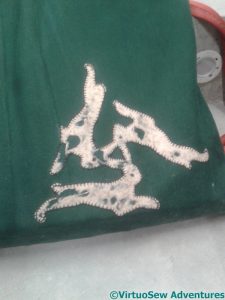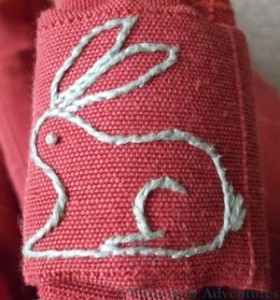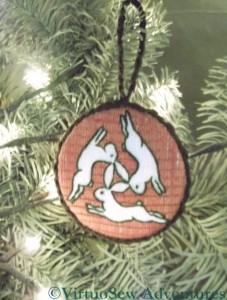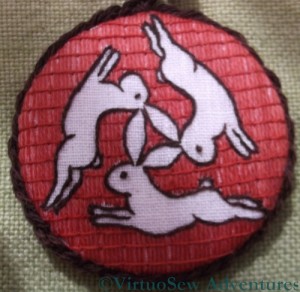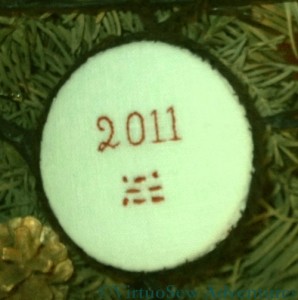Tag: The Three Hares
Three Rabbits – or are they Hares?
Rummaging around as I try to reorganise the house, I’ve rediscovered a bag I made some time ago.
The Three Rabbits (or Hares) design is an ancient one, found all along the Silk Route and in many different cultures. I’ve seen it in textiles and ceramics, carved as mere outlines, polychrome with a wealth of fabulous detail. I’ve also seen variants with animals other than hares, and even variants with more animals in the circuit.
I think I first encountered it when I first met David Singmaster, the mathematician and metagrobologist – it’s one of his many interests, and he has a drawstring bag decorated with the design that he takes everywhere, stocked with mathematical puzzles and games to entertain anyone who comes near. I saw it recently when David and his wife were at a conference my husband and I attended, and his wife remembered that her mother had had to remind her of how to do the French Knots for the eyes. I took delight in noting the puzzled brows that ensued whenever David took anything out of the bag!
My version is one of the simplest, I suspect. I designed a very simple circuit of hares (or rabbits!), and embroidered it using chain stitch on a russet coloured furnishing fabric. The bag is padded with wadding and lined with the same fabric.
Finally I designed a small buckle-type ornament made of a strip of fabric embroidered with a very definite bunny embroidered in stem stitch, and put one on each end of the strap.
I’m intending to do a much more complicated version one of these days, maybe with a mille-fleurs background like the tapestries in the Musée de Cluny.
Watch this space, as they say!
Another variation on the Three Hares
When I wrote about the Three Hares design I created for Handmade Living magazine, I mentioned that I was rather taken with the design as a framework for experimentation. I have an idea in my head for quite a big project based on the design, but while that’s simmering away and developing in my head, I have gone in the other direction.
This is a much smaller and much more complex version, but maintaining the historical connection, I chose to use Bayeux Stitch (there is a diagram in this Embroiderer’s Guild pdf) for the background. The stitching uses fine woollen threads on a linen ground, and naturally I followed my usual habit of increasing the complexity of my adventures in stitchery.
Bayeux Stitch is worked in two phases, of which the first is surface satin stitch. I chose to alternate two shades of rust for the surface satin stitch, and then the couching stitches went over the top using the darker shade. It doesn’t really show in the photographs, which were taken in rather dismal lighting conditions, but it does show in real life, and it makes the background shimmer slightly – which is a good trick when there’s no metallic thread involved!
Whereas in the first variant, created for Handmade Living magazine, I simply outlined the design, gaining all of the interest from the contrast of fabric and thread, in this case I outlined the motif (in back stitch), then covered the background completely with stitching.
Finally, I turned the embroidery into a hanging decoration by the same method used for the Glittering Snail, but before I covered the back with fabric, I added the year and then my initials in Morse Code.
Published!
Some time ago I worked on a project I couldn’t tell you about, and this is it. There’s a new magazine in the UK – I think this one is issue 4 – which is called “Handmade Living”. It covers a huge variety of subjects, from knitting and embroidery to handmade soap and natural skincare. In order to bring all these subjects together, the editorial team have themes in mind for each issue, and when I suggested a few ideas to the editor, she thought that The Three Hares would fit nicely in the “Folk” theme. The Three Hares is a very old design, so she was absolutely right. It’s appeared all along the Silk Route…
I chose to use several of my favorite stitches, and worked the design as simply as possible. I’ve had a few ideas about using the design to experiment with some of the embroidery and needlework styles I’ve not played with yet – there are plenty of them, after all! – and it seemed sensible to start with a simple technique.
And by the way, if you’ve come to visit my blog after reading the magazine – Welcome! I hope you enjoy what you read…


